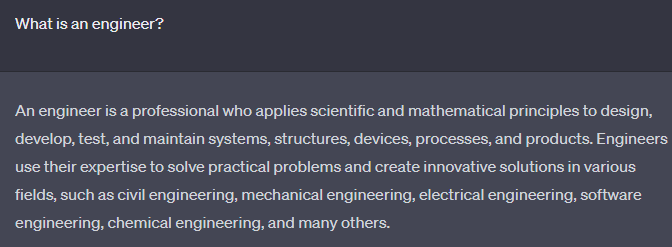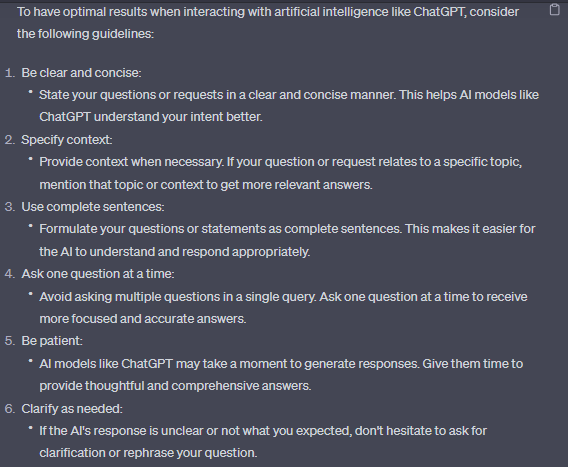What is ChatGPT?
A modern Artificial Intelligence: ChatGPT is a language model developed by OpenAI, based on the GPT-3.5 architecture, which is an improved version of its predecessor GPT-3 (There is currently a paid ChatGPT-4). This model is part of the GPT (Generative Pre-trained Transformer) series, which uses advanced machine learning and natural language processing (NLP) techniques to generate coherent and contextually appropriate responses to user questions or requests.
GPT-3.5 is a large Artificial Intelligence model that has been trained on a vast amount of textual data to learn linguistic and contextual patterns. This enables it to efficiently and coherently generate responses, writings, translations, and complete tasks.
ChatGPT can be used in a variety of applications, such as chatbots, virtual assistants, content generation, language translation, and more. Its ability to understand context and generate realistic responses makes it useful in various human interaction situations, enhancing the user experience in applications involving natural language.

How does ChatGPT work?
Imagine ChatGPT’s source code as a massive knowledge book on language and conversations. This book contains millions of pages, each of which holds information about words, phrases, grammar, and how different sentences can make sense together. The goal of this book is to help ChatGPT understand your questions and provide relevant answers.
When you interact with ChatGPT, you ask a question or write a message, and the model’s source code takes that input and processes it page by page in the giant book. It reads the words, examines how they are organized, and looks for patterns to understand what you are asking.
The model has the ability to learn from all the examples of conversations and texts it has seen during its training, allowing it to have a vast amount of accumulated knowledge in that book. Thanks to this, it can predict the most suitable answer to your question based on patterns it has found in the past.
Once it has processed all the relevant pages, the model generates a response for you, which we hope is coherent and useful. This response is like a new page written in the book, adding to its knowledge so it can improve its responses in future interactions.
It’s important to mention that while ChatGPT is very good at many natural language tasks, it doesn’t have a real understanding of meaning like a person would. It simply finds patterns in the text to generate coherent responses based on its training in previous data.
In summary, ChatGPT’s source code is like a massive book of linguistic knowledge that the model uses to understand your questions and generate relevant responses based on the patterns it learned during its training.
What limitations does it have?
Despite being an impressive language model, ChatGPT also has certain limitations. It’s worth noting that for users of ChatGPT-3.5 (the free version), it is not currently connected to the internet, and it has all the internet data available up to the year 2021. Therefore, it may not be updated on certain topics. Other limitations include:
- Lack of contextual knowledge: Although ChatGPT has been trained on a vast amount of data, it doesn’t have a true understanding of the world and cannot maintain a coherent context in an extensive conversation. This means it can lose track of a conversation if the context is unclear or if a series of unrelated questions are asked.
- Tendency to generate invented responses: ChatGPT can generate responses that sound plausible but are actually invented and not supported by verifiable facts. This can lead to incorrect or misleading answers in certain cases.
- Sensitivity to ambiguous questions: If asked an ambiguous or poorly formulated question, ChatGPT may provide a response that seems relevant but doesn’t truly answer the question or doesn’t make sense.
- Inherent biases: Because the model is trained on internet data, it can reflect cultural and social biases present in that data. This means it can provide responses that contain unwanted prejudices or stereotypes.
- Risk of inappropriate responses: Since ChatGPT learns from examples provided by humans, it can absorb inappropriate language and content if presented with it. Although efforts are made to filter offensive content, there is still a residual risk.
- Limitations in creativity and deep reasoning: While ChatGPT can be surprisingly creative in certain cases, its ability for deep reasoning and solving complex problems remains limited compared to human thinking.
- Use of sensitive data: In the past, there have been reported cases of ChatGPT providing sensitive information such as credit card numbers, passwords, or personal data if asked inappropriately.
It’s important to consider these limitations when using ChatGPT for critical tasks or when accurate and reliable information is needed. While it is a powerful tool for many applications, it cannot completely replace human reasoning and may require supervision and care in its use.
How to Use ChatGPT?
To begin using this Artificial Intelligence, it’s important to understand that the version available for free on the internet is ChatGPT-3.5, while ChatGPT-4 currently costs $20 (U.S. dollars) per month.

– You should visit the OpenAi website. – – Log in with a Gmail, Apple, or Microsoft account.

After that, you will be able to see a screen like the following:

After that, you can start using the Artificial Intelligence.
How to Get the Most out of ChatGPT?
ChatGPT is an Artificial Intelligence based on a language model. Therefore, all requests should be in the form of written text. This is known as a “Prompt.” A prompt is a set of words, images, or data that triggers content generation through an Artificial Intelligence software. The quality of the information provided by the Artificial Intelligence depends largely on the quality of the prompt given. The more specific and detailed it is, the better the results obtained.
Here are examples to understand how the content delivered varies depending on the prompt:
Poorly written prompt:

More specific prompt:

(This was the complete text provided by the AI; you can ignore it if you wish)
An engineer is a highly trained professional specializing in applying scientific, mathematical, and technical principles to design, develop, implement, and maintain technological solutions that solve practical problems and meet human needs. Engineers work in a wide range of fields and sectors, from industry and construction to technology, medicine, and the environment. Their main goal is to create efficient, safe, and sustainable solutions to improve the quality of life and societal progress.
Types of engineers:
- Civil Engineer: Specializes in the design, construction, and maintenance of infrastructure such as roads, bridges, buildings, airports, water, and sanitation systems, among others. Civil engineers play a crucial role in urban and rural development, ensuring the safety and functionality of structures we use daily.
- Mechanical Engineer: Focuses on the design and manufacture of mechanical systems, machines, and devices. They work in various industries, from automotive to aerospace, and are responsible for developing solutions to enhance equipment and machinery’s efficiency, durability, and performance.
- Electrical Engineer: Specializes in the study and application of electricity and electronics. They design and develop electrical systems, electronic devices, power generation and distribution systems, telecommunications, and information technologies.
- Software Engineer: Focuses on the creation and development of computer programs and applications. They work on design, coding, testing, and maintenance of software for various purposes, including mobile applications, operating systems, business software, and video games.
- Chemical Engineer: Deals with the transformation and production of chemicals and materials on a large scale. They design and operate industrial plants, develop safe and sustainable chemical processes, and contribute to the research of new materials and technologies.
- Environmental Engineer: Focuses on environmental protection and conservation. They work to reduce the negative impact of human activities on nature, designing waste management systems, recycling projects, environmental impact assessments, and solutions for climate change.
- Aerospace Engineer: Specializes in the design, development, and manufacturing of aircraft and space systems. They work on projects ranging from airplanes and helicopters to satellites, rockets, and spacecraft.
- Biomedical Engineer: Applies engineering principles to the fields of medicine and biology. They contribute to the design and development of medical equipment, prosthetics, diagnostic systems, and technologies to improve people’s health and quality of life.
- Industrial Engineer: Focuses on improving efficiency and productivity in industrial and business processes. They analyze, design, and optimize production systems, logistics, supply chains, and operations management.
- Telecommunications Engineer: Designs, implements, and maintains communication systems, data networks, transmission systems, and telecommunications technologies.
Importance and History of Engineering:
Engineering has been essential for the advancement of humanity throughout history. Since ancient times, engineers have contributed inventions and developments that have transformed society. For example, engineers in ancient Rome built aqueducts and drainage systems that allowed broader urban development and improved the quality of life for residents.
During the Renaissance, engineering experienced a resurgence with great figures like Leonardo da Vinci, who was an engineer, artist, and inventor. He contributed designs for flying machines, bridges, and advanced weaponry.
The 19th-century Industrial Revolution marked a milestone in engineering history, leading to the mechanization of industry and the development of machinery that spurred rapid economic and technological growth worldwide.
In the 20th century, engineering diversified into different fields and became a highly specialized discipline. Engineers were instrumental in expanding infrastructure, developing new technologies, advancing medicine, and improving global communication.
Today, engineering remains crucial in addressing global challenges such as climate change, sustainability, urbanization, and the development of information and communication technologies. Engineers are key agents in innovation and the search for solutions to improve the quality of life and preserve the environment for future generations.
(End of ChatGPT’s quoted text)
How to Create a Prompt Correctly?
The importance of generating an appropriate prompt in Artificial Intelligence is fundamental to obtain high-quality responses. In the provided example, it’s clear that the prompt was not formulated optimally, affecting the quality of the responses. Fortunately, you can leverage ChatGPT’s capabilities to get guidance on how to write an effective prompt and achieve optimal results.


Conclusion:
It’s evident that ChatGPT’s Artificial Intelligence can be a valuable tool for various tasks, such as content generation, data analysis, organization, and research. However, it’s essential to be aware of the limitations of this technology, as we have observed. Understanding these limitations and developing proficiency in handling Artificial Intelligence is crucial to improving our results in its use.
The success of our interactions with Artificial Intelligence like ChatGPT depends on the ability to craft accurate and detailed prompts, which will allow us to obtain quality responses. While Artificial Intelligence offers many advantages, it’s crucial to comprehend its limitations and develop proper competence in its use to maximize its capabilities and effectively achieve our objectives.
For more information, you can refer to the Artificial Intelligence section.
References
– OpenAi
About The Author
Samuel Parariá
Estudio: University of Francisco de Paula Santander.
Major: Civil Engineering.
Favorite Areas: Structures, Traffic Engineering, and Road Design.
Location: Cúcuta, Norte de Santander, Colombia.







Related
What is Artificial Intelligence and How to Use It?
Artificial Intelligence Reveals Humanity’s Historical Mistakes!